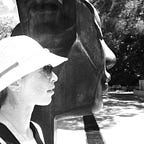Decoding Authenticity in the Age of AI & Mixed Reality
The word “authentic” was anointed the word of the year in 2023 by Merriam-Webster — reflecting its prevalence in discussions around social media, technology, culture, politics and identity. Encapsulating both the complexity and hypocrisy of the topic, ‘The Curse’, a new show by Benny Safdie and Nathan Fielder, starring Emma Stone, fixates on the concept of authenticity in our modern and nuanced world. The series probes fundamental questions: What truly warrants our concern or merits attention — what is public perception versus our internal convictions? Do we navigate the delicate balance of intentions, scrutinize the substantive core of actions and behaviors, or do we steadfastly focus on the ultimate outcomes?
“The Curse”: A Reflective Mirage
“The Curse is co-creator Nathan Fielder and Benny Safdie’s twisted reflection of the American dream. The “genre-bending” series follows newlywed couple Asher and Whitney Siegel as they embark on shooting an HGTV show set in Encinas, New Mexico. Whitney’s dream is to create a green community of homes (mirrored houses) which have absolutely no carbon footprint on the environment. The irony is that members of the mostly Latinx and Indigenous community have to be displaced in order for the ostentatious houses to be built” (source: Decider)
When I first started watching “The Curse”, I actually found the show to be somewhat awkward and laborious, which is consistent with Fielder and Safdies previous work. Surprisingly, the show grew on me as I realized that it was painstakingly dissecting the many contradictions around the ubiquitous use of the term authenticity in today’s culture.
“We are in a time where everyone feels pressure to tell their story and who they are, but not everyone is a storyteller. Not everyone is a filmmaker, not everyone is a writer. So, the people that aren’t the most skilled at doing this stuff, how do they do it? What is the real version if they can’t execute it well? Is that a fake version of them, or is that honest?” (source: Indie Wire, Nathan Fielder)
Now I am absolutely hooked on “The Curse” and just watched the final, mind bending episode this weekend. What has captivated me about this show is how it exposes intimate, moral, and social issues that most people prefer to keep hidden. The houses the characters inhabit, constructed with mirrors, project a polished, filtered facade. However, we as viewers are encouraged to look around the facade and critically assess the characters based on their true selves, not just their projected images.
AI’s Transformative Tapestry: Reality in Flux
One can interpret the ‘The Curse’ as a metaphor for our modern world. In this context, technology and social media play crucial roles in shaping how we perceive the world and help us achieve our goals. Further, as our world is increasingly being shaped by artificial intelligence, digital influencers, and virtual content, our boundaries, expectations, and understanding of reality are constantly evolving. AI tools like ChatGPT, MidJourney, and DALL-E, coupled with social and augmented filters, empower us to transform our appearances and expressions in diverse ways.
We can now generate content and claim expertise without actually originating the ideas ourselves. This raises questions about the fairness of the playing field as we navigate a world where distinguishing between original, altered, and replicated content becomes increasingly challenging
In this synthetic and artificially constructed landscape, ensuring authenticity in identity, communications and action is a growing concern. As disinformation, cybercrimes, and deepfakes proliferate, how can we guarantee that individuals and companies are genuine in their expressions, and how can we hold them more accountable for their words and actions?
The Curse of Inauthenticity (spoiler alert)
In the perplexing season finale of “The Curse,” the repercussions of unrestrained inauthenticity unfold as Nathan Field’s character, Asher, is catapulted beyond the confines of Earth into the cosmic void. This expulsion into outer space can be interpreted as a symbolic cosmic retribution, a consequence for a character personifying the pervasive insincerity portrayed throughout the series. The Universe, in meting out its own version of justice, underscores the idea that there’s a limit to how long artificiality can endure within the human spirit.
Towards Greater Awareness: New Standards for Authenticity in a Synthetic World
Reflecting beyond the fictional realm of the series ‘Curse,’ I continue to contemplate the current inadequacy of evaluation and accountability methods in sync with today’s dynamic media and technology landscape. It goes beyond a simple dichotomy of labeling content as either fake or real; rather, our challenge lies in skillfully discerning the varying degrees of adaptation, recontextualization, and augmentation in both individuals and objects. The increasing fusion of social media with the blurring lines between physical and digital content necessitates a heightened awareness, precise language, and the establishment of new standards and mechanisms to authenticate genuine authenticity across personal and business spheres.
In my exploration of methods to authenticate and decipher our evolving reality, I acknowledge that technology alone cannot address broader societal issues tied to intention, morality, and human behavior. However, I am optimistic about taking steps to bolster safeguards and transparency concerning the authentic origin, alteration, and ultimate presentation of digitized content and experiences. Over the next few weeks, I plan to delve into topics such as digital watermarking and encryption, biometric authentication, deepfake detection, and zero-knowledge proofs.
Starting to address these issues today may help keep our society from becoming cursed.
Narrative by Rori DuBoff with grammatical assistance by ChatGPT
